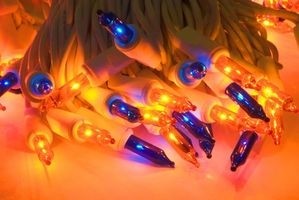Christmas Electrical Safety

Now that you're preparing to decorate your home for the holidays, you'll want to make sure that you're practicing electrical safety when decorating the inside and outside of your home with Christmas lights. This will not only make your home more appealing, but will prevent damage and injury.
Testing for Safety
Any Christmas lights or decorations that require lights (such as plastic figures of reindeer or wreaths that light up) should be tested for safety before they are put on display. The plastic or glass casing that surrounds the light should be intact, and should not contain any cracks or breaks. The wires and cords must be inspected for frays and tears, and it's best to plug the lights into an electrical socket in the home to ensure that all bulbs are properly illuminated.
Plugging in Lights
If lights leading to the driveway, front door, or garage are usually plugged in for the home, it's important to make sure that there are enough electrical outlets for the Christmas lights, without having to unplug the functional lights for the inside of the home. Using a surge protector, or applying Christmas lights to one specific section of the yard (such as the center of the front yard, the steps leading to the front door), will help to prevent an electrical shortage, and will keep the lights from starting an electrical fire.
Weather Safety
When hanging Christmas lights or lighted decorations outside, the cords for the lights should be attached firmly to the side or front of the home, or another secure post in the front or back yard. This will protect the lights from wind damage, and will keep cords from being loose in the yard, so that residents and guests will not trip over them in instance where the ground may be slippery or wet.
Christmas Trees
Christmas lights can be used to decorate real and synthetic Christmas trees, but should never be used on trees made from metal, as this can present a serious safety hazard. Lights should be in their best condition before being placed on the tree; lights that are not working well, or lights with a casing that is broken can give the Christmas tree an electrical charge, and can electrocute anyone who touches the tree. The lights on the Christmas tree, as well as the additional electrical decorations inside or outside of the home, should be turned off when residents leave the home or go to bed every night in order to avoid an electrical fire.
Child Safety
Christmas "bubble" lights were popular in the 1950's and contain colored liquid. These should be kept away from children, as the covering of the lights can be broken, and children may attempt to drink the liquid inside. Strings of lights should be kept tucked away or taped to walls so that children can not easily pull the cords and injure themselves or damage furniture.
Testing for Safety
Any Christmas lights or decorations that require lights (such as plastic figures of reindeer or wreaths that light up) should be tested for safety before they are put on display. The plastic or glass casing that surrounds the light should be intact, and should not contain any cracks or breaks. The wires and cords must be inspected for frays and tears, and it's best to plug the lights into an electrical socket in the home to ensure that all bulbs are properly illuminated.
Plugging in Lights
If lights leading to the driveway, front door, or garage are usually plugged in for the home, it's important to make sure that there are enough electrical outlets for the Christmas lights, without having to unplug the functional lights for the inside of the home. Using a surge protector, or applying Christmas lights to one specific section of the yard (such as the center of the front yard, the steps leading to the front door), will help to prevent an electrical shortage, and will keep the lights from starting an electrical fire.
Weather Safety
When hanging Christmas lights or lighted decorations outside, the cords for the lights should be attached firmly to the side or front of the home, or another secure post in the front or back yard. This will protect the lights from wind damage, and will keep cords from being loose in the yard, so that residents and guests will not trip over them in instance where the ground may be slippery or wet.
Christmas Trees
Christmas lights can be used to decorate real and synthetic Christmas trees, but should never be used on trees made from metal, as this can present a serious safety hazard. Lights should be in their best condition before being placed on the tree; lights that are not working well, or lights with a casing that is broken can give the Christmas tree an electrical charge, and can electrocute anyone who touches the tree. The lights on the Christmas tree, as well as the additional electrical decorations inside or outside of the home, should be turned off when residents leave the home or go to bed every night in order to avoid an electrical fire.
Child Safety
Christmas "bubble" lights were popular in the 1950's and contain colored liquid. These should be kept away from children, as the covering of the lights can be broken, and children may attempt to drink the liquid inside. Strings of lights should be kept tucked away or taped to walls so that children can not easily pull the cords and injure themselves or damage furniture.
- 2f1e4aef23af3e82a19026f5ef49fe39db.jpg
References
http://img.ehowcdn.com/615x200/ehow/images/a06/6o/of/christmas-electrical-safety-800x800.jpg
http://img.ehowcdn.com/615x200/ehow/images/a06/6o/of/christmas-electrical-safety-800x800.jpg